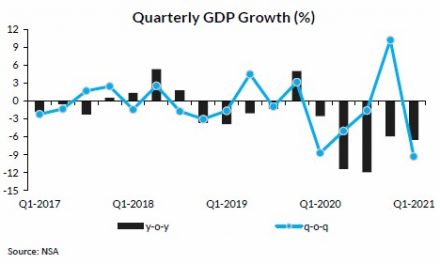
Weak Rand undermines currency link

The recent weakening of the South African Rand has undoubtedly triggered the erosion of the primary benefits of the fixed exchange rate embedded in the Common Monetary Area (CMA) agreement. The arrangement which entails that Namibia pegs its currency to the Rand has been beneficial in several ways, but since the recent downward spiral of the Rand, these benefits are gradually eroding. This situation has brought to the fore the fundamental question of whether Namibia should explore alternative exchange rate regimes that will better serve Namibia’s developmental interests.
Price Stability
The primary benefit that Namibia has been enjoying from the arrangement is that of price stability. It is believed that when a country pegs its currency to the currency of a country that has low inflation, it tends to import low inflation from that particular country. In fact since 1993 the domestic inflation rate has closely mirrored the prevailing rate in South Africa. However, all this is set to change following the recent depreciation of the Rand against the major currencies of the world. A further weakening in the Rand will see the cost of imported goods for consumers rise, making it more expensive for consumers to purchase items such as imported electronics or other durable and semi-durable items sourced from abroad. As we all know, Namibia imports between 75% and 90% of its consumables from South Africa, meaning that Namibia will definitely import these from South Africa at even higher prices should the Rand continue to fall.
Credibility
Many governments in developing and developed countries have for a number of reasons experienced difficulties in making their policies generally credible. Namibia was fortunate enough to align its policies with that of the CMA of which South Africa was the main anchor immediately after independence. With the aim of establishing a credible policy environment, membership of the CMA and the rule-based policies, such as the restrictions placed on government borrowing became necessary and were hence instrumental in raising the government’s credibility.
The continued weakening of the Rand has undoubtedly set in motion waves of doubt on the South African policy credibility and credibility being one of the key benefits Namibia enjoyed from the arrangement, Namibia definitely has all the reasons to be concerned.
Exchange rate fluctuations
Another major advantage of the fixed exchange rate arrangement was that it helped to avoid exchange rate fluctuations and reduces the unfavourable effects of exchange rate uncertainty on trade and investment. Given the fact that South Africa was and remain Namibia’s main trading partner, a major benefit for Namibia was the elimination of uncertainty associated with exchange rate variability.
More worrying is the fact that Namibia’s trade with the rest of the world is priced in South African Rand – a currency that has become extremely volatile. The hunt for a more stable anchor currency must begin immediately.
Alternative Exchange Rate Systems
In the absence of a documented official plan B exchange rate regime, Namibia can still explore the following three basic choices. These choices can be used in determining the appropriate exchange rate regime – a monetary linkage between the Namibian economy and the rest of the world. Namibia can let its currency float freely in the exchange markets against all other currencies, or it can fix the price of its currency against a specific foreign currency or a basket of foreign currencies. Furthermore, Namibia can pursue intermediate approaches, letting rates float to some extent but intervening to limit those fluctuations either ad hoc (“managed floating”) or pursuant to some pre-determined parameters (“target zones,” or “crawling bands”.)














































